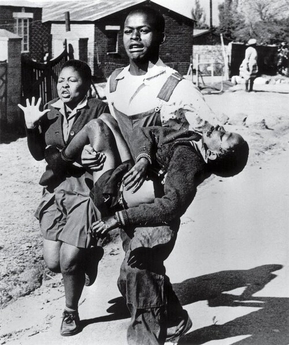The Soweto Massacre of 1976: Youth Resistance, Apartheid Education, and Its Lasting Legacy
1. Background and Causes of the Soweto Massacre
1.1 Apartheid and the Education System
Under apartheid, the country’s minority white population limited black South Africans’ access to education. Policies, such as the Bantu Education Act of 1953 which enforced racially segregated learning facilities, aimed to restrict black youths to menial labor.
- “The Bantu Education Act” (Article, Overcoming Apartheid). A detailed explanation of the 1953 law that institutionalized racially segregated education under apartheid.
- “South Africa’s Extension of University Education Act of 1959” (Article; ThoughtCo, 2025). This law further entrenched apartheid in higher education by limiting Black students to designated “tribal colleges”.
- “Soweto and Its Aftermath” (Academic article; JSTOR, 1978) A thorough analysis of the socio-political and educational context of 1976.
- “Legacy of apartheid still haunts pupils fighting for a decent education in South Africa, 30 years later” (Article, Daily Maverick, 08/02/24). This article explores how the inequality in education that began under apartheid still affects South African learners today.
- “Then and Now: The Legacy of Bantu Education in South Africa” (Article; Medill Reports Chicago, 2020). A comparative look at the historical impact of the Bantu Education Act and how its legacy persists in present-day schooling.
- “The Youth Take Charge: The Soweto Uprising of June 1976” (Resource; South African History Archive). Highlights how the oppressive the Bantu Education system became a catalyst for youth activism.
1.2 The Afrikaans Medium Decree and Student Opposition
The 1974 decree mandating Afrikaans as the language of instruction further alienated black students, who saw it as the language of their oppressors. This sparked widespread protests, culminating in the Soweto protests.
- “Soweto Uprising” (Encyclopedia Entry, Britannica, 2025). Describes how the 1974 decree mandating Afrikaans as a language of instruction triggered widespread student protests.
- “Soweto Uprising: Children Who Marched Against Apartheid” (Podcast, BBC, 2024). First-hand accounts of students resisting linguistic and educational oppression.
2. The Events of June 16, 1976
Thousands of students peacefully marched in Soweto to protest the Afrikaans policy. The police opened fire, killing hundreds of school children.
- “Why the Soweto protests erupted” (Article, BBC News, 2006). Provides historical background on why students protested in 1976 and the broader socio-political context of apartheid repression.
- “The 16 June 1976 Soweto students’ uprising – as it happened” (Article, Southafrica Gateway, 2024). An hour-by-hour account of the 1976 Soweto students’ protests.
- “Soweto Uprising: What Happened to My Dad?” (Podcast, BBC, 2019). A personal narrative that humanizes the experience of families caught in this tragedy.
- “‘I Saw a Nightmare…’ Doing Violence to Memory: The Soweto Uprising, June 16, 1976” (Article, Gutenberg‑e, 2006). An academic exploration of how the memory of the Soweto massacre has been shaped, remembered, and contested over time.
3. Key Figures and Symbols
3.1 Hector Pieterson and His Legacy
Hector Pieterson, a 12-year-old killed by the police, became a powerful symbol of this tragic event. His memory continues to inspire campaigns for better education and justice.
- “This is Not What My Brother Died For” (Article; News24, 2021). Hector’s sister launches a campaign for better education in memory of her brother.
- “Hector Pieterson Museum Receives Prestigious Award” (News Report; City of Johannesburg, 2024). The Hector Pieterson Museum, which preserves Pieterson’s legacy, was awarded the prestigious Outstanding Museum Award.
3.2 Tsietsi Mashinini, Student Leader
Tsietsi Mashinini, a student at Morris Isaacson High School and the president of the Soweto Student Representative Council (SSRC), was one of the main organizers of the 1976 march.
- “Tsietsi Mashinini (1957)” (Article, The Presidency). Highlights Mashinini’s leadership in the 1976 Soweto protests and his lasting legacy as a symbol of youth resistance against apartheid.
- “Young, Cool and Defiant” (Article, Sunday Times Heritage Project). An account of Mashinini’s charisma and boldness.
- “South African Government Suppresses Soweto Student Rebellion” (Article, EBSCO, 2023). Summarizes the South African government’s harsh response to the Soweto protests and how it fueled resistance and international criticism.
3.3 A photograph as a symbol of resistance
Sam Nzima’s photograph of a dying Hector Pieterson shocked the world and exposed apartheid’s brutality. The image became an enduring symbol of resistance and global solidarity.

- “Capturing the Soweto Uprising: South Africa’s most iconic photograph lives on” (Rhodes University, 2018). Examines Sam Nzima's legendary 1976 image of Hector Pieterson being carried after being shot, highlighting its role in revealing apartheid brutality and inspiring continuous artistic memorials and public debate.
- “Soweto Uprising: The Story Behind Sam Nzima’s Photograph” (Video; TIME, 2017). Chronicles the global impact of the photograph of Hector Pieterson.
Soweto Uprising: The Story Behind Sam Nzima's Photograph
- “This Photo Galvanized the World Against Apartheid” (Article; TIME, 2016). Explores how a single image captured the brutality of apartheid and mobilized international outrage.
- “The iconic Hector Pieterson photo and the power of adaptations” (Article, SciELO SA, 2019). Analyzes how the iconic photograph of Hector Pieterson has been reinterpreted in media and art, reinforcing its role in South Africa’s collective memory.
- “The Legacy of Sam Nzima’s Iconic Photo Will Live On in Palestine” (Opinion; Middle East Monitor, 2018). Discusses the universal resonance of Nzima’s photo in human rights struggles.
- "Soweto uprising 40 years on: the image that shocked the world" (Article, The Guardian, 2016). Reflects on the enduring impact of the Hector Pieterson photograph and its role in galvanizing international outrage against apartheid.
4. The Aftermath of the Massacre
The international community condemned South Africa’s repression, leading to protests, sanctions and growing isolation. The bloodshed marked a shift in international support for the anti-apartheid movement.
- "1976 Soweto Uprising: Youth rebellion and the burning desire for freedom" (Article, Peoples Dispatch, 2020). Explores the roots of the 1976 protests and how young people’s defiance against apartheid ignited a broader struggle for liberation.
- “World Politics Explainer: The End of Apartheid” (Article; The Conversation, 2018). Places the Soweto protests within a global context and explains its contribution to the end of apartheid.
5. The Legacy of the Soweto Massacre
5.1 Changes in South African Society and Politics
Although apartheid eventually ended in the early 1990s, inequality, especially in education, remains deeply rooted. The Soweto massacre eventually led to social change but left many hopes unfulfilled.
- “South Africa: 30 Years After Apartheid, What Has Changed?” (Article; Al Jazeera, 2024). Evaluates the progress and ongoing challenges since apartheid’s fall.
- “Remembering Soweto: 40 Years On, Inequality Remains” (Article; DW, 2016). Highlights how the demonstrations inspired broader anti-apartheid resistance within South Africa.
- “From the Archives: What the Legacy of the June 16 Soweto Uprising Means Today” (Article; Daily Maverick, 2024). Reviews the state’s violent reaction and its consequences.
- “The school at heart of Soweto Uprising…” (Article, The Times, 2024) Gives an update on Morris Isaacson High School, connecting past events to the present.
5.2 The Commemoration of Youth Day (June 16)
Youth Day honors the bravery of 1976 students and serves as a national day of reflection and recommitment to justice and equality in South Africa.
- “Youth Day Honors 1976 Soweto Uprising Against Apartheid” (News Report; AllAfrica, 2024). Explains how June 16 is observed in remembrance of student resistance.
- “Honouring Youth Day: The Legacy of June 16 in South Africa” (Article, Sunday Independent, 2025). Discusses how Youth Day continues to serve as a powerful reminder of student resistance and the ongoing struggle for equality in South Africa.
5.3 Influence on Future Generations and Movements
The spirit of the Soweto demonstrations live on in today’s youth-led movements. While challenges persist, the legacy of resistance continues to inspire political action and advocacy.
- “The Important Role of Youths in South African Politics” (Article; Democracy in Africa, 2025). Reflects on how the protests inspired continued youth engagement in politics.
- “South Africa: The Spirit of SA’s 1976 Soweto Youth Uprising Lives On in Today’s Generation” (Article; AllAfrica, 2024). Describes how present-day youth connect with the legacy of 1976.
- “South Africa Has One of the World’s Worst Education Systems” (Article; The Economist, 2017). Analyzes the ongoing crisis in South African education, rooted in apartheid-era policies.
- “4 Lessons on Organizing From the Anti-Apartheid Movement” (Article, Teen Vogue, 2020). Offers a modern, youth-focused take on how the Soweto demonstrations inform activism today.
- "UAZA commemorates Soweto Uprising, voices support for Ukrainian youth fighting for freedom" (Opinion, Ukranian World, 2025). Draws a parallel between South Africa’s student protests of 1976 and modern youth struggles for freedom, highlighting international solidarity.
Pour citer cette ressource :
Reda Boulkhiam, The Soweto Massacre of 1976: Youth Resistance, Apartheid Education, and Its Lasting Legacy, La Clé des Langues [en ligne], Lyon, ENS de LYON/DGESCO (ISSN 2107-7029), juillet 2025. Consulté le 10/01/2026. URL: https://cle.ens-lyon.fr/anglais/civilisation/commonwealth/the-soweto-massacre-of-1976-youth-resistance-apartheid-education-and-its-lasting-legacy



 Activer le mode zen
Activer le mode zen